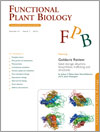
Functional Plant Biology
Volume 41 Number 7 2014
FP14035Seed storage albumins: biosynthesis, trafficking and structures
Seed storage proteins are arguably one of the most important sources of protein for humans and their abundance saw them become the subject of many early studies in plant protein biochemistry. This paper provides an overview of the post-translational processing and three-dimensional structures of the napin-type albumins. Despite decades of excellent research on storage proteins, questions remain to be answered.
FP13195Diversity and species identity effects on fine root productivity and turnover in a species-rich temperate broad-leaved forest
It has been suggested that mixed forests may be more productive than mono-specific forests, but not much is known about belowground (root) production. With an ingrowth core study in 100 plots in an old-growth forest, we show that species identity is important, whereas species diversity per se influenced only fine root turnover but not fine root production.
FP13306Physiological, proteomic and transcriptional responses of wheat to combination of drought or waterlogging with late spring low temperature
The increasing climatic variability results in wheat being exposed to more frequent adversities including combined low temperature and drought/waterlogging. The physiological, proteomic and transcriptional responses of wheat plants to these combined stresses were reported. The knowledge will help comprehensively understand the climate change impacts on wheat production and help optimise water management strategy to cope with the abiotic stresses.
FP13311Antioxidant enzyme activities and gene expression patterns in peanut nodules during a drought and rehydration cycle
It is well known that drought is an environmental stress that negatively affects peanut growth and nodulation; however, plant recovery analyses are scarce. This study establishes a framework for analysing the response of biological nitrogen fixation and antioxidant systems in a drought–recovery cycle. Efficient and dynamic regulation of antioxidant enzymes during the cycle is crucial for the restoration of normal redox metabolism within 3 days after onset of rehydration.
FP13323Modification of the expression of two NPR1 suppressors, SNC1 and SNI1, in soybean confers partial resistance to the soybean cyst nematode, Heterodera glycines
Major losses in soybean production are reported annually due to the attack of the soybean cyst nematode. Soybean roots were transformed to modify the expression of two genes involved in the defence mechanism of plants against pathogens, and their response to nematode attack was studied. The treatments conferred enhanced resistance to the cyst nematode, providing an interesting strategy to improve crop protection against pathogens.
FP13229Distinction and characterisation of salinity tolerant and sensitive rice cultivars as probed by the chlorophyll fluorescence characteristics and growth parameters
Designing an effective phenotyping strategy requires thorough understanding of plant survival under salt stress. This study aimed at characterising rice cultivars differing in salinity tolerance based on changes in chlorophyll fluorescence characteristics, growth parameters and ion accumulation. Salinity factor index calculated from PIABS clearly distinguished tolerance level among the cultivars. Some new salt-tolerant cultivars were identified, which could serve as donors in breeding programme and for identification of additional QTL/genes.
FP13269Alternative electron sinks are crucial for conferring photoprotection in field-grown cotton under water deficit during flowering and boll setting stages
The mechanism of drought tolerance may be related to a photoprotective feature in cotton plants. Mehler-peroxidation reaction, photorespiration and nitrate metabolism serve as efficient alternative sinks for excess electrons to maintain electron transport flux. They are important photoprotective mechanisms in field-grown cotton to cope with drought.
FP13333Jasmonic acid is associated with resistance to twospotted spider mites in diploid cotton (Gossypium arboreum)
Cotton genotypes resistant to debilitating spider mite infestations could be used to breed mite resistant commercial cultivars and reduce yield loss and pesticide use. We found that jasmonic acid was present at higher levels in the resistant genotype. Jasmonic acid represents a possible selection tool to dramatically speed up breeding of mite resistant cotton cultivars.
FP13305Overexpression of a pepper CaERF5 gene in tobacco plants enhances resistance to Ralstonia solanacearum infection
ERF transcription factors are implicated in a range of biological processes. However, molecular functions of most pepper ERFs remain uncharacterised. We have shown that overexpression of a pepper CaERF5 gene in tobacco enhances resistance to a bacterial disease, likely by activation of defence genes. Our results suggest that CaERF5 acts as a positive regulator in plant defence, and that overexpression of CaERF5 can be used to enhance disease resistance in crop species.
FP13314Plasmalemma localisation of DOUBLE HYBRID PROLINE-RICH PROTEIN 1 and its function in systemic acquired resistance of Arabidopsis thaliana
The function of AtDHyPRP1 in defence response of Arabidopsis to bacterial and fungal pathogens was determined with overexpressing and RNA interference lines. AtDHyPRP1 was localised to plasmalemma and was associated with systemic acquired resistance. As a lipid transfer protein, AtDHyPRP1 is probably involved in perception and translocation of long-distance signals derived from biotic stresses via vascular tissue or plasmodesmata.




